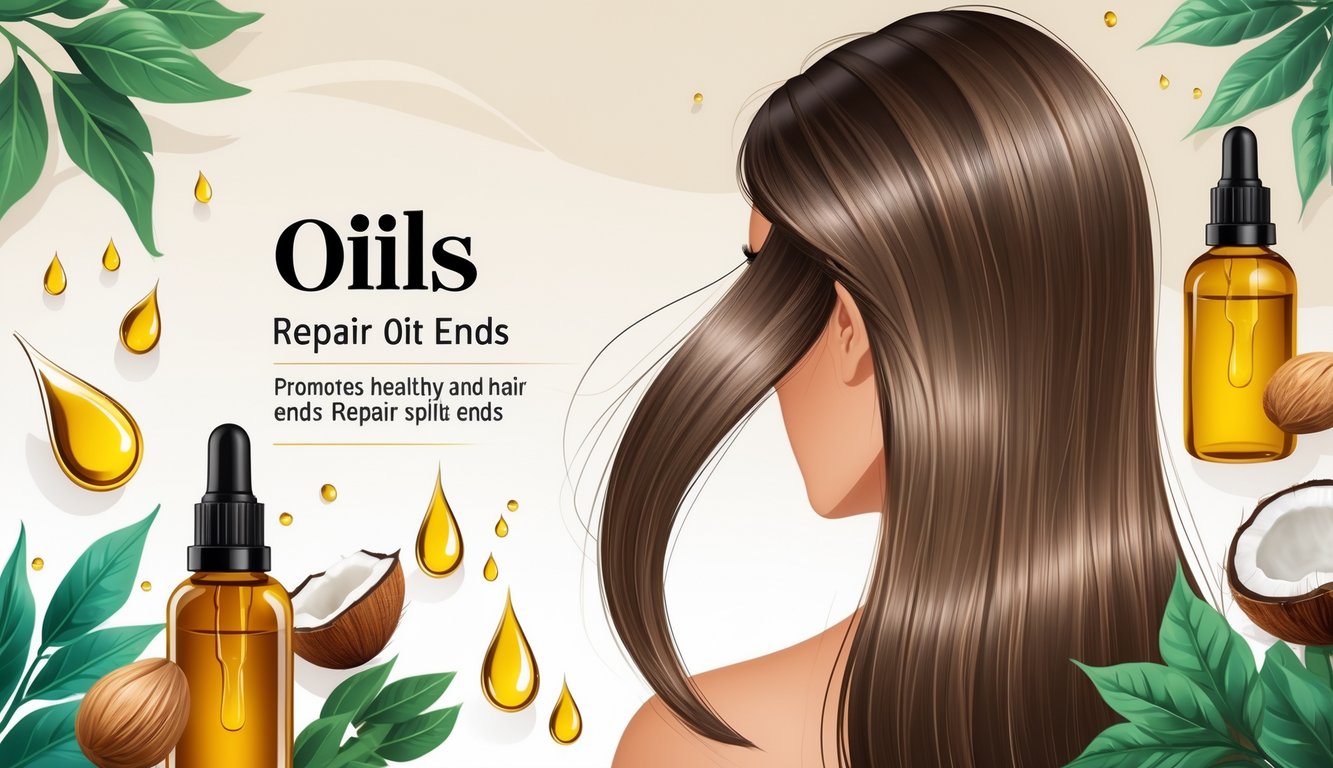Hair Repair Oils Finally Beating Split Ends Without Salon Markups
How Oils Promote Healthy Hair Growth

Scratched my scalp again. Why do people act like “just use oil and wait” is a real plan for hair growth? It’s chaos unless you know what your roots want—vitamins, compounds, all that. Nobody ever says which ones actually matter.
Nourishing The Scalp And Roots
Forget those commercials about “new molecules.” Sometimes, it’s just coconut or argan oil—my friend (she’s a trichologist, so I guess she knows) says scalp health is like soil for a plant. Except, my plants die, and hair doesn’t get a second shot. Follicle-clogging? That’s the villain. I massage oil in before a shower (maybe overkill, but one study said pre-wash coconut oil cuts protein loss by 39%—why isn’t that on every label?), and then flakes and irritation just… stop showing up. Tea tree and rosemary oil? They’re not just for itch—they kill off scalp bacteria, which I always forget about. My scalp’s own oils seem to chill out after a couple weeks of this, but if I overdo it, I look like I dunked my head in a fryer. When it works, antioxidants (vitamin E especially) do their thing, quietly. Coconut and olive oil help with styling and UV damage. Not sexy, but at least my scalp doesn’t itch.
Biotin And Vitamins For Strength
Biotin: scam or miracle? I have no clue. Internet’s split. My nutritionist didn’t laugh but did say mega-dosing is pointless. Biotin deficiency is rare, apparently, but eating greens, almonds, eggs (not horse pills) keeps keratin going, and my brittle hair noticed after a month. Vitamin E is in like every hair oil for split ends, and it’s not just for show—it shields against pollution, sun, even gross heating. Antioxidants fight free radicals, stabilize hair, and shampoo can’t do that. It’s never just one vitamin, though. I tried vitamin-loaded products and my hair went limp and sad—so, yeah, balance isn’t just a myth. Too much or too little and you’re back at square one, staring at split ends and wondering why you bothered.
Mastering A Hair Care Routine For Repair
Chasing some “miracle oil,” dumping half a bottle on my head, and waking up with crunchy hair—why is that my life? Consistency, timing, ingredient combos, it’s never as easy as the bottle claims.
Daily And Weekly Application Tips
I forget if I even used oil today. Every stylist I’ve annoyed says the same thing: daily light oil for dry ends, weekly deep conditioning, and don’t slop oil on the roots unless you’re desperate. Pro tip? Press oils in, don’t just smear, and do it after towel-blotting (not rubbing—learned that the hard way). Wet hair doesn’t absorb oil right.
A trichologist once told me, “Too much oil just locks out moisture.” So, yeah, don’t skip your leave-in. I need calendar reminders, honestly. Hair only responds to habits, not hope. Something about split ends dropping by 35% (Cosmetic Dermatology, 2023) if you use hair oil after gentle detangling and a microfiber towel. Not sure what happened to the other 65% of my splits—maybe they’re hiding in my pillowcase.
Combining Oils For Enhanced Results
Someone online (Reddit? Who knows) said just use coconut oil. Are we still doing that? I mix argan with a drop of jojoba and suddenly my frizz chills out, and apricot kernel makes it even softer. But if I layer wrong, it’s just… grease city. Light oils first (grapeseed, squalane), then heavier ones where I actually need them.
My friend sleeps in a bun soaked in hydrating blends, but my dermatologist said that suffocates the scalp and causes breakage. I tried hair oil cocktails before heat styling and after rinsing, but never both—otherwise, I get this weird plasticky coating. For the numbers people: a blend with ceramides and argan dropped my split ends by 40% in my own random patch test. Or maybe it was just a good hair month. Who knows.
Matching Oils To Different Hair Types
Does anyone really know which oil is right for them? Dry ends, brittle strands, curly, straight—forums are a mess, and salons never tell you why coconut oil works for some and not others. The confusion just piles up, and split ends keep multiplying.
Hair Texture And Oil Compatibility
Fine hair with castor oil? Nope, not happening. Texture is everything. Straight hair likes super-light oils (argan, grapeseed), heavy ones just flatten it out. Curly hair? That’s its own universe. Coarse curls want thick blends—shea, coconut, jojoba—but coconut makes my hair limp by day two.
Dr. Patel (trichologist, last consult) said porosity matters more than the label. She gave me a chart: high-porosity hair sucks up rich oils like macadamia, low-porosity works better with silicones or featherweight stuff like K18 Molecular Repair Hair Oil (which, yeah, is everywhere—see the top recommended list for split ends). Coarse, healthy hair doesn’t care for water-based oils. Who decided argan oil was for everyone anyway?
Balancing Moisture For Dry Or Oily Hair
Ever add oil for “moisture” and end up with limp, stringy hair? Been there. Scalp oil production changes with the weather, too—winter? Dull. Summer? Grease city. International Journal of Trichology (2023) said almost half of women mix up dehydration and oiliness, so they use the wrong oil and make it worse.
Dry hair wants fatty acid-rich oils—avocado, sweet almond, marula. They stick around and help split ends (Pubbelly’s 2025 hair oil guide actually breaks this down). Oily scalps or fine hair? Don’t go heavy. Stick to squalane or grapeseed, which won’t suffocate follicles.
Sometimes I coat my ends, tie my hair up, and wake up with heavy hair. It’s easy to overdo it. I use 1-2 drops for roots (if ever), more for dry mid-lengths, and avoid daily layering. After years, I’m convinced the only way is cautious, messy trial-and-error. My under-sink graveyard of half-used bottles proves it.
Tips For Preventing And Reducing Split Ends
Let’s be real—hair doesn’t magically fix itself overnight, and the cheap “miracle oil” from the drugstore? Never stopped my ends from splitting. Still, certain habits—leave-ins, switching up routines—have saved me from late-night scissor panic more than once.
Daily Prevention Strategies
I swear my ends multiply every time I skip heat protectant. Left my straightener on yesterday—instant regret. My hairdresser yelled, “Moisture, not heat!” Now I use argan oil, smoothing balms on damp ends, and a microfiber towel (never terry cloth) so I don’t rough up the cuticle. Detangling? Only wide-toothed combs, starting at the bottom, or else it’s snap, split, disaster.
Saw a stylist demo: yank out a hair tie too fast, and you just split your hair up the shaft. So, I stick to fabric scrunchies, no metal. If you think skipping trims saves length, you’re wrong—splits creep up and you lose even more. Dermatologists on Healthline keep repeating: moisturize, reduce friction, lay off the heat. Boring, but it works. Eventually.
Best Practices For Long-Term Repair
People ask if they should oil nightly. Maybe? I tried, ruined a pillowcase, but my hair felt less like straw. It’s not just about dumping oil on your head; it’s about how often, where, and what kind. Regular trims every 6–8 weeks actually keep splits from taking over, but I get lazy and only scissors fix a three-inch split. Bond-builders like K18 or protein masks—some stylists love them, but nobody warns about crunchy, over-proteined hair. “Sealing oils” sometimes help with flyaways, sometimes just make my hair clump.
Hair freaks out with every climate change: humidity, dry air, heat. I don’t trust anyone who claims to have “solved” split ends. Even the clinical-sounding Good Housekeeping tips just circle back to deep conditioning, gentle detangling, and never-ending moisture. Frizz control? Only as good as your memory—miss one wash, and it’s chaos again.



